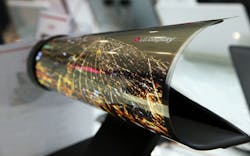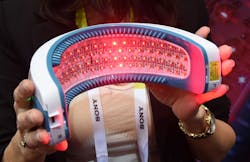In early January, an army of technologists, engineers, and gadget geeks descended upon the Las Vegas Convention Center for their annual high-tech pep rally.
CES—the world's largest technology and innovation show—is where the future is defined. The concepts and world premieres of tomorrow's critical tools, systems, and toys are hauled here from across the world every year to give the public a glimpse at all the next big things.
This year's event—buzzing with drones and the whir of 3D printers, filled to capacity with over 170,000 attendees spaced out in virtual reality or recording their every step with smart wearables—brought together nearly 4,000 companies, displaying 20,000 new products and technologies.
It was 2.47 million square feet of undiluted innovation—all of the gadgets, tools, vehicles, technologies, and high-tech stuff that will find its way into our lives and into our jobs in the coming months.
Some of these are devices are silly. Well, a lot of them are silly.
But there are also plenty of brilliant new concepts revealed at the event, many of which have the potential to impact the manufacturing and business worlds in profound ways.
We have gone through this year's product lineup to pick out a few of these industrial (or at least industrialized) tools to let you know what we're in for. We've also included a few silly ones, just because.
Smart Helmet
The DAQRI Smart Helmet might be the coolest thing at the show. When I imagine manufacturing in the future, everyone is wearing something exactly like this.
The smart helmet is part safety device and part augmented reality display.
The protective screen displays real-time, contextually relevant information to workers right on top of the real world around them. This gives them seamless access to the critical data of any smart machine running around them, acting as a wearable user-machine interface for an Industrial Internet of Things operation.
It looks like the future and acts like the future. That's all I want in the world.
The Future of Personal Transportation?
There were a million drones at CES 2016, all of them offering slightly different functionality and capabilities. But this one sort of sticks out from the rest.
Though it looks like any other quadcopter on the market, the EHang 184 drone isn't built for RC enthusiasts. It's built for transportation.
The 18-foot long, 440-pound copter can transport a solo passenger up to 63 miles per hour for about 23 minutes.
Even better, its navigation system is completely autonomous—passengers enter their destinations, press a button, and the EHang does all the work.
It's the closest we've come to the Jetsons.
Bendy Screens
This is LG's latest offering—an 18-inch paper-thin display that is apparently flexible enough to be rolled up like a newspaper.
It brings all of the high-definition, web-enabled functionality to a form factor all of us old-school readers still prefer.
Industrial Smartglasses
Vuzix's M3000 smartglasses are everything we thought Google Glass was going to be.
It represents a two-year mission to create a pair of smart glasses that are slim enough, sleek enough, and powerful enough to fulfill all of the productivity-boosting promises the technologists have been teasing for years.
The system trades that Google Glass-style design for a thin, fully see-through lens that falls over one eye. When activated, the 1.4-millimeter lens transforms into a vivid screen overlaying data, instructions, even video or MES data seamlessly into the wearer's vision without interrupting their work or obstructing their line of sight.
What's more, it carries its own onboard processor with built-in-memory, so it doesn't simply provide a hands-free connection to a smartphone or computer—though it is designed to do that as well—it is a computer unto itself, with the capability to process and store information in-house or via wireless or Bluetooth connection to enterprise software systems.
Battery on Wheels
Maybe the best part of CES is all of the wacky concept cars that automakers roll out to wow the geeks. This one seems especially fun.
Toyota's FCV Plus, running on hydrogen fuel cells, is basically a giant battery on wheels. The design allows the car to generate electricity directly from hydrogen stored outside and, once fueled up, can double as a stable source of electric power for use at home or on the go.
While this is certainly a fun concept vehicle, the design speaks to something far more interesting to the market.
Our basic notion of energy generation, storage, and transmission is being rocked by new pressures and new technologies.
This is one interesting application of the trend, but the impact through the market is limitless.
Light Speed Prototyping
3D printers are always a big draw at CES, and this year was no exception.
After seeing NewPro3D’s Intelligent Liquid Interface (ILI) process, you get the feeling that a superlative needs to precede “rapid prototyping.” The company explains ILI as integrating “a clear wettable membrane between the photo-curing resin and the light source.”
This allows the Candian-based manufacturer to create an object 51-millimeters in diameter in only 4.5 minutes. It takes a polyjet printer 180 minutes to accomplish the same task. According to 3Dprint.com, NewPro3D is also developing a 3D printer to make 25-foot turbine blades in 16 hours and a faster way to 3D print metal.
Instant Translation
As the workplace becomes more diverse and more globalized, devices like these are going to be absolutely essential.
Logbar's iLi wearable translator records and audibly translates speech into English, Chinese or Japanese (and eventually French, Korean, Thai, Italian, Spanish, and Arabic languages) in real time, essentially cutting the language barrier to briefly awkward pause.
Robot Projector
Though it is marketed as a "home robot," the Cerevo Tipron internet-connected projection robot may lend itself a bit better for the factory floor than your living room.
This mobile entertainment system is capable of projecting an 80-inch HD (1280 x 720) display from about 10 feet away.
The camera range of motion reaches 90-degrees along the pitch, yaw, and roll axes, and the 31-inch body can collapse to 15 inches while charging or transiting.
For the estimated 1,000 to $2,000 price tag, you could just buy a few smart TVs to mount on your walls. In an industrial environment, having an automated, battery-powered projector on call to flash schematics on a wall, or to project videos in the training room makes more sense.
Read more about the Cerevo Tipron
Smart Belt?
We have smart glasses, smartwatches, and smartphones. Why not a smart belt?
Introducing the Samsung Welt—a new smart device designed to monitor your waistline in real-time (in case of sudden changes?) and digitally sync your progress via a smartphone app. It also keeps your pants up.
Techno-Hair
Okay, this one has absolutely no manufacturing application, but it's wacky enough to make our list.
As the company puts it, Pinin Farina's USD 795 uses 90-second treatments of red laser light at 655 nanometers to grow hair by increasing blood flow to the scalp and stimulating hair follicles.
Cure your bald spot with lasers. Sounds legit.
About the Author
Travis Hessman
VP of Content, Endeavor Business Media
Travis Hessman is the VP of Content for Endeavor Business Media. Previously, Travis was the Editor-in-Chief for Industry Week and New Equipment Digest as well as the Group Editorial Director for Endeavor's Manufacturing Group.
He began his career as an intern at IndustryWeek in 2001 and later served as IW's technology and innovation editor. Today, he combines his experience as an educator, a writer, and a journalist to help address some of the most significant challenges in the manufacturing industry, with a particular focus on leadership, training, and the technologies of smart manufacturing.
John Hitch
Editor, Fleet Maintenance
John Hitch, based out of Cleveland, Ohio, is the editor of Fleet Maintenance, a B2B magazine that addresses the service needs for all commercial vehicle makes and models (Classes 1-8), ranging from shop management strategies to the latest tools to enhance uptime.
He previously wrote about equipment and fleet operations and management for FleetOwner, and prior to that, manufacturing and advanced technology for IndustryWeek and New Equipment Digest. He is an award-winning journalist and former sonar technician aboard a nuclear-powered submarine where he served honorably aboard the fast-attack submarine USS Oklahoma City (SSN-723).











